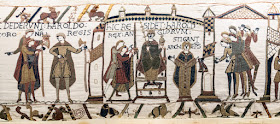Bayeux was founded as a Gallo-Roman settlement in the 1st century BC under the name Augustodurum. The city was largely destroyed during the Viking raids of the late 9th century but was rebuilt in the early 10th century under the reign of Bothon. The cathedral was completed by William Is half brother Odo, Earl of Kent and dedicated in 1077.
 |
| Bayeux Cathederal Notre Damme |
 |
| Bayeux Tapestry Harold Crowned King of England |
 |
| Bayeux Tapestry Battle of Hastings |
The city began to lose prominence when William moved his capital to Caen.
Bayeux had a turbulent history. It was burned to the ground by Henry 1 of England following the defeat of his brother in the struggle for the rule of Normandy. Under Richard the Lionheart the city prospered. During the Hundred Years War it was repeatedly pillaged until captured by Henry V in 1417. The city returned to French control in 1450 when it was recaptured by Charles VII of France following the Battle of Formigny.
Bayeux returned to prosperity and stone buildings began to replace the old wooden structures.
 |
| Bayeux Water Mill |
The German Blitzkreig quickly overpowered the Allies, forcing the British Expeditionary Force to evacuate through Dunkirk. Another operation launched on 5th June 1940 outflanked the French Army on the Maginot Line. Paris fell on the 14th June.
An armistice between France and Germany was signed 22nd June 1940, and France was divided into various zones, primarily the Occupied Zone under German control, and the Free Zone where Marshall Petain formed the Vichy Government. Bayeux was in the German Military Zone.
On the 11th November 1942, Allied forces invaded Vichy French North Africa in Operation Torch prompting the Germans to occupy the Free Zone and take control.
For French people, life in German occupied France was marked by daily privation, in the curtailing of freedom and the lack of vital needs, like food. The German requisitions were the principal cause. In Normandy, many farms provided food to the occupying troops who were mostly stationed on the coast.
 |
| German Orders to the French People |
 |
| German Propaganda and Orders Battle of Normandy Museum |
 |
| German Orders and French Resistance Graffiti Battle of Normandy Museum |
The German reaction to resistance was brutal. Deportation and executions, as well as reprisals against innocent civilians were perpetrated by the occupying forces. Deportations of French Jews and other people were also a feature of Nazi rule, many thousands loosing their lives.
 |
| Bayeux Town Hall |
 |
| Bayeux Town Hall WW2 Memorial |
On 6th June 1944, the Allied forces landed on the Normandy Beaches.
Bayeux lay in the area of GOLD BEACH, the 50th (Northumbrian) Division Area. By the evening of June 6th, the British had landed 25,000 men on Gold Beach and were in control of a quadrilateral measuring roughly ten kilometres by ten. Most of the day’s objectives has been achieved. The advanced elements of the 50th Division were within sight of the N13 trunk road and the outskirts of Bayeux on the evening of D-Day.
 |
| Men of 50th (Northumbrian) Division move inland -Day 6th June 1944 |
Bayeux became the first French town to be liberated on 7th June 1944.
 |
| British Troops Bayeux June 1944 |
 |
| General De Gaulle Bayeux 14th June 1944 |
 |
| Bayeux 1944 |
 |
| Bayeux 2015 |
"NOS A GULIELMO VICTI VICTORIS PATRIAM LIBERAVIMUS"
“We, once conquered by William, have now set free the Conqueror’s native land.”
 |
| Bayeux Memorial |



